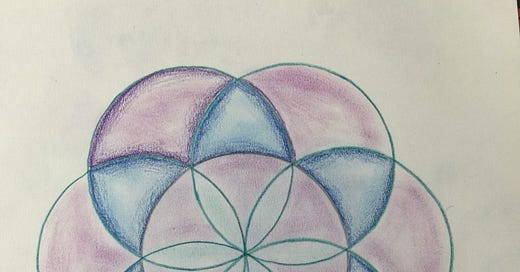📐6th Grade Geometry Constructions
And a few thoughts about why this really is my favorite block (I swear, this time I mean it!)
I’m a huge fan of the 6th Grade Geometry block, and it’s not just because you get to create some truly beautiful drawings.
It’s because, if you ask me, it encapsulates everything that the 6th-grade curriculum is about, and it does so beautifully!
I tend to think about the history curriculum to understand the theme for each grade, and 6th-grade, with its focus on Ancient Rome, is a perfect example. Rome is all about lawful ingenuity, and it’s exactly what the sixth grader is hungry for.
They want to be creative and understand the wonders of the world (physics!), but they want to understand the lawfulness of it. The sixth-grader wants to know that the world makes sense, and that there are laws and rules that govern the world’s phenomena.
I mean, when you’re standing on the precipice of adolescence, some hard and fast rules are pretty comforting (even if you fight with your parents about them).
The geometry block is all about understanding and then applying that lawfulness to create beautiful, harmonious constructions. This block is also a moment when the curriculum hearkens back to earlier grades. My approach to the block is very much an updated version of the Quality of Numbers block from first grade. We discuss where we see one-ness, two-ness, etc. in the world, and then we explore geometric constructions that align with those numbers. I rely heavily on the fantastic book The Beginner’s Guide to Constructing the Universe by Michael Schneider, which is just fantastic (especially if you like to geek out about numbers in the world).
A huge component of the block, and what I think truly displays the lawful quality, are the constructions. Using just a compass, pencil, and straightedge, students learn to construct various geometric constructions like a parallel line, a perpendicular bisector, and others. In the past, I relied on the instructions in Jamie York’s book Making Math Meaningful, but instructions are now published in lots of places online.
I’m going to create a few videos that demonstrate the constructions, starting with the perpendicular bisector. (Paid subscribers can watch the video below. If you’re not a paid subscriber, the link above should give you what you need.)
When teaching this to the students, I generally guided them through the process step-by-step. When I first learned the constructions myself, they felt so foreign to me that I was ready for it to be difficult for my students. I was a little blown away when, after they learned the first couple of constructions, they started figuring them out for themselves.
For a review activity, I often had my students go through the process of the construction and write out instructions as they went. A few of our main lesson pages for the block were these instructions, and one year, I had students write out instructions for their parents to follow at a parent evening. Super fun.
Do you have a favorite curriculum moment like this? Or questions about how a certain part of the curriculum fits in? I’d love to hear in the comments.
Keep reading with a 7-day free trial
Subscribe to Waldorf at Work to keep reading this post and get 7 days of free access to the full post archives.





